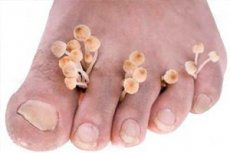Medical expert of the article
New publications
Fungus on the feet: how to treat?
Last reviewed: 05.07.2025

All iLive content is medically reviewed or fact checked to ensure as much factual accuracy as possible.
We have strict sourcing guidelines and only link to reputable media sites, academic research institutions and, whenever possible, medically peer reviewed studies. Note that the numbers in parentheses ([1], [2], etc.) are clickable links to these studies.
If you feel that any of our content is inaccurate, out-of-date, or otherwise questionable, please select it and press Ctrl + Enter.

How does foot fungus occur?
Even if a person constantly and regularly washes his feet, he cannot wash off all the bacteria. There are simply fewer of them, but they do not disappear completely. And they multiply very, very quickly as soon as a person steps on the floor, puts on slippers or - even more favorable for bacteria - shoes, boots or sneakers.
In a warm and humid environment, especially if your feet sweat, the fungus simply thrives. If such an environment coincides with an inflammatory process in the body, poor resistance to infections or excessive sweating of the feet - write it off. The fungus is right there.
Symptoms of foot fungus
It affects the area between the toes, on the nails, on the soles of the feet, and the top of the foot remains untouched. If the fungus is already in a chronic stage, then the skin of the feet and other parts of the body is very dry, peeling, there are keratinized layers of skin, microcracks on it.
Along the border of the area where the fungus is located, a red, inflamed strip is clearly visible, the skin behind which is rough, dry and flaky.
If the fungus has not been treated for a long time, quite noticeable cracks appear on the skin behind the fungus area, which hurt terribly. If a bacterial infection is added to them, then severe pain in the legs appears, which puts a person in a hospital bed, since it is impossible to walk because of this pain.
Is fungus transmitted from one person to another?
There is a common belief (and many believe it) that the fungus is transmitted from person to person, that it can be infected. However, if a person has already received the fungus, it spreads very quickly over the entire area of the foot.
To prevent the process from becoming painful and depriving a person of the ability to walk, it is necessary to begin treating the fungus at the initial stage of the disease.
Who to contact?
How to treat fungus in acute form?
First of all, you need to put a sterile bandage on the foot, but not too tight. Pharmacies sell an antifungal infusion - in medical terms it is called antimycotic, that is, antifungal. You need to moisten a bandage with this infusion and put it on the area affected by the fungus.
This operation should be repeated every time as soon as the bandage dries. When you see that the fungus has not settled on the foot so intensively, its manifestations begin to decrease, you should not stop antifungal wraps. Otherwise, the manifestations of the fungus will return again. If there are cracks on the feet, you need to protect them from the penetration of pathogenic bacteria by bandaging the affected area.
During treatment, it is very important that the feet are not exposed to hot temperatures or water, as this will further promote the spread of the fungus. The surface of the feet should also be dry and clean.
You also need to treat your foot by taking vitamins and taking antimycotic (antifungal) medications. You should not ignore your doctor's recommendations - he will advise you on what medications are needed for treatment. A person can get a fungus if he forgets to wipe his feet after washing - a damp environment promotes the spread of infections.
What can you wear on your feet if you have a fungus?
If a person suffering from foot fungus still goes to work, and the season is cold, it is worth stocking up on several pairs of stockings or tights (for women), several pairs of socks (for men), which need to be changed 3-4 times a day. This will prevent the infection from spreading further. What the patient puts on his feet should be made of natural materials, including shoes.
Shoes should not be tight or narrow, but comfortable – this will allow the foot to feel comfortable, and the skin to not sweat so often, multiplying bacteria and fungus.


 [
[